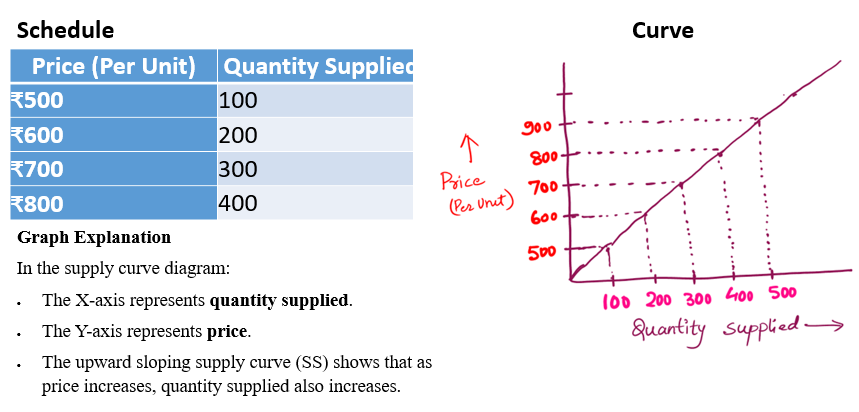Supply and Law of supply
- Supply refers to the quantity of a commodity that firms or sellers are able to produce depending on the resources available to them, technology, and employees for producing a commodity.
- How much of a commodity the firm will be willing to offer for sale depends on the profit they expect to make from producing and selling the commodity.
- Profit in turn depends on the price of the commodity on one hand and unit cost of production on the other hand.
Law of Supply
- The law of supply states the functional relationship between the price of a commodity and its quantity supplied.
According to the law:
When the price of a commodity increases, the quantity supplied of that commodity also increases;
and
when the price falls, the quantity supplied decreases—other factors remaining constant. Thus, according to the law of supply, quantity supplied is directly or positively related to price.
Supply Schedule and Curve

Determinant of Supply
- The term determinants of supply refers to the various factors that influence the quantity of goods or services that producers are willing and able to offer for sale at different prices.
- While price is the main factor, several non-price elements also play a crucial role in determining supply decisions.
- Price of the Commodity:
Higher price encourages producers to supply more, and lower price reduces supply.
Example: If laptop prices rise, manufacturers produce more laptops.
- Prices of Related Goods:
If the price of an alternative product rises, producers may shift to that product.
Example: A farmer may grow wheat instead of rice if wheat prices increase.
3.Cost of Production
- Higher costs reduce supply, while lower costs increase it.
Example: A rise in fuel prices increases transportation cost and reduces supply.
4.Technology
- Better technology increases efficiency and output, thus increasing supply.
Example: Use of modern machinery increases supply in the automobile industry.
5. Government Policies :
- Taxes reduce supply, while subsidies encourage production.
Example: Subsidy on fertilizers increases supply of crops.
6. Expectations of Future Prices:
- If producers expect prices to rise, they may hold current stock, reducing supply now.
Example: Oil companies may reduce supply today if they expect future price hikes.
- Number of Sellers
More producers in the market increase total supply; fewer producers reduce it.
Example: Entry of new car companies increases supply of vehicles. - Natural and Climatic Conditions
Favorable weather increases supply; unfavorable reduces it.
Example: Drought reduces supply of agricultural products.
- Prices of Inputs
Rise in input prices increases cost and reduces supply.
Example: Increase in steel prices reduces supply of cars.
- Means of Transportation and Communication
Better transport facilities help increase supply by reducing delivery delays.
Example: Improved highways increase supply of perishable goods.
Exceptions to the Law of Supply
- The Law of Supply states that, other things being equal, the quantity supplied of a commodity increases with an increase in its price, and decreases with a fall in price.
However, in certain cases, this law does not hold true — these are known as exceptions to the Law of Supply
- Perishable Goods
Producers of perishable goods (like fruits, vegetables, milk, etc.) cannot wait for prices to rise. They have to sell their goods even at lower prices to avoid spoilage.
Example: A vegetable seller sells all his stock in the evening, even at a reduced price, to prevent wastage
- Rare or Artistic Goods
Goods such as paintings, antiques, and rare collectibles have a fixed supply, which cannot be increased even if prices rise.
Example: The original painting of the Mona Lisa cannot be supplied in more quantity regardless of its price.
- Future Expectation of Price Fall
If producers expect the price of a commodity to fall in the future, they may increase supply now even at the current lower price — to avoid losses later.
Example: Farmers may sell their crops immediately if they expect prices to decline after harvest.
- Agricultural Products
Supply of agricultural goods largely depends on natural conditions (like rainfall, temperature, and soil fertility) rather than price.
Example: A good monsoon can lead to high supply even if prices are low, and a poor monsoon may cause low supply despite high prices.
- Necessities or Compulsory Production
Sometimes, suppliers are legally or socially required to produce certain goods regardless of price.
Example: Electricity boards or water supply departments must continue production even if prices are regulated or low.
